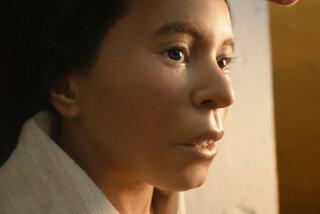X-Rays Solve a Cold Case: An Arrow Killed Iceman
- Share via
ROME — It took about 5,300 years to find the body and an additional decade to perform the autopsy, but researchers in Italy now say they know what killed the Iceman: He was shot with an arrow.
Who fired it--a rival hunter, perhaps, or a warrior in battle--is still under investigation as scientists work to reconstruct the life and death of the Bronze Age’s best-preserved mummy, in search of precious knowledge about that prehistoric time.
The mummy’s caretakers announced the latest discovery Wednesday at a news conference in Bolzano, Italy. X-rays “revealed a sensation: a flint arrowhead is visible in the left side of the thorax,” said Bruno Hosp, president of the South Tyrol Museum of Archeology.
The Iceman’s frozen corpse turned up in 1991 when two German hikers noticed it protruding from an Alpine glacier near the Italy-Austria border 11,000 feet above sea level. The ice also preserved a treasure trove of prehistoric artifacts--the metal, wood, fruit, hay, grass, leather and weapons that composed his worldly possessions.
Since then, the Iceman and his stuff have been pored over by protohistorians, archeologists, anthropologists and students of anatomy, medicine, forensic dentistry and nutrition from all over the world. They flock to his refrigerated, chapel-like room at the museum, which was built specially for him and where tourists can view him through a small window.
So far, researchers have learned from carbon dating that the Iceman lived early in the Bronze Age, which ran from 3500 to 1000 BC. Microscopic analysis of a sample removed from his intestines last year revealed that he ate meat, unleavened bread and an herb or green plant for his last meal.
Pollen in that food told scientists that it was springtime and that the Iceman had been in a valley hours before climbing to the heights where he died face down in a large rock hollow. They have even calculated his age at death: about 45 to 50 years old.
But the cause of his demise had been a mystery because the fatal puncture wound was so tiny, barely visible on his shrunken skin.
The X-ray revealing the inch-long arrowhead was made last week using a technique called computerized tomography, which produces a multidimensional image.
Eduard Egarter Vigl, the mummy’s chief curator, said the arrow was fired into the left side, shattering the scapula and tearing through nerves and major blood vessels before lodging just below the left shoulder near the lung. The Iceman probably survived no more than a few hours, the curator said.
Until now, scientists had entertained several theories about how the Iceman died. DNA from his lungs suggested that he was afflicted by a fungus that might have caused him to fall ill in the snow. Because he was armed with an ax, knife, bow and 14 wooden arrows, they assumed that he died on a trek to hunt game.
The new finding has upset carefully built scenarios about his death.
“All the things that have been published over the past seven or eight years--that he died because of broken ribs, that he died under the snow, or that he was exhausted and lay down and fell asleep and froze to death--are wrong,” said Alex Susanna, a museum official. “Maybe there was a combat, maybe he was in a battle. There is a whole series of new implications. The story needs to be rewritten.”
More to Read
Sign up for Essential California
The most important California stories and recommendations in your inbox every morning.
You may occasionally receive promotional content from the Los Angeles Times.











